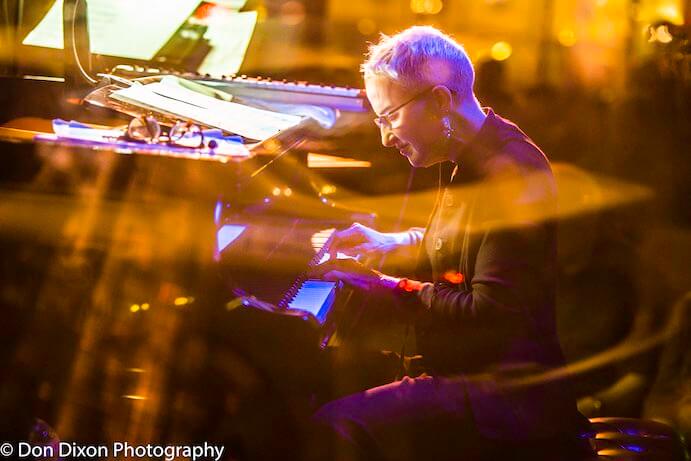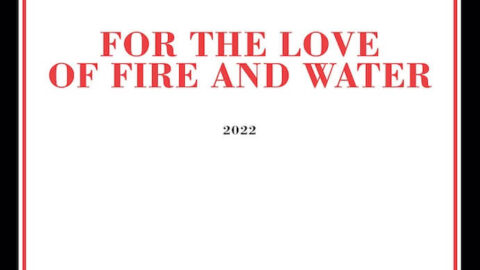On April 8, 2022, pianist and composer Myra Melford is releasing her full-length album For the Love of Fire and Water on RogueArt. The album features Melford herself on piano and melodica, Mary Halvorson on guitar, Susie Ibarra on drums and percussion, Ingrid Laubrock on tenor and soprano saxophones, and Tomeka Reid on cello. Melford has worked with all of these artists previously, but never together in an ensemble, and the resulting pieces are an ever-evolving and expanding debut of an entire series inspired by the work of artist Cy Twombly, from whom the album’s title draws inspiration.
The album begins with “I,” a rolling and disorienting work that adds layers in one at a time. Piano keys bounce up and down as the cello’s playful atonality skates in. Like a tango between two dancers, both instruments explore their own improvisations but come back into harmony here and there. As the cello and piano begin to lull into a unifying rhythm, Ibarra rattles in with light and warm percussion, followed by saxophone. The guitar and saxophone add a deeper weight to the overall timbre, building into more and more cacophony before eventually unraveling. “I” could have very well ended in a crescendoing swell of improvisational apex, but Melford cleverly subverts that expected structure and lets Halvorson’s glissandos on the guitar wind the composition down, melting into the next song.

“II” carries the energy of the previous piece into a new direction with more rhythmic uniformity between the piano and drums, and the guitar and saxophone playing parallel to each other. “III” presents a reverberating shimmering style of guitar, which at times adds strong support to the saxophone’s quick bursts of notes. However, in other moments, especially when the guitar begins to loosely mirror the saxophone in tone and rhythm, both voices nearly swallow each other.
“IV” interrupts the frenetic energy of the album so far with a more soft, textured approach. Detuned Filipino gongs played by Ibarra punctuate sustained tones in the cello and saxophone, and the piece also features a syrupy yet ethereal solo complete with quarter-tones by Reid. “V” recalls the shimmering guitar of “III” but recreated in an uncannily similar way by Melford this time by rapidly striking the high register keys and incorporating glissandos.
By now, it’s apparent that the odd-numbered pieces keep returning to the same style of improvisation while each even-numbered piece introduces a new approach and structure. “VI” stays quiet, playing again with texture through plucking, creaking, and tapping, while “VII” explores lower ranges of the piano and pushes towards the direction of free-form jazz.
“VIII” takes on a completely new direction initially, by having the musicians clap in unison. The claps slowly pull away as each instrument creeps in, but when they return, they are out of sync, as if the two voices are playing entirely different songs. However, when the claps pause and return again in the finale, they fall back into place.

Throughout the whole album, Melford lets most of the compositions build, but reigns them in before they fully explode. In “IX,” however, the piece swells into a grand release, as if Melford has finally allowed herself, and the rest of the musicians, to finally let loose, releasing the suspense that built up throughout the album in a spectacular explosion of sound. During the first listen, I felt that this climax should have come sooner, but upon revisiting the album, this free and loud piece could not have been more perfectly placed, especially with the sweet, somber tone of “X.” It is here that Melford ties the whole album together, drawing less from improvisation and more from chamber music.
Melford has crafted a perfectly complex album that demonstrates the tight control that gives rise to artful improvisation. Contrary to the expectation that improvisation is random, Melford masterfully creates harmony out of discord and structure out of free-form approaches. The album moves the listener through, calling upon musical motifs without too much rehashing while the swells gain just the right amount of momentum without muddling or drowning each other out. Overall, For the Love of Fire and Water creates a sense of dizzying vertigo without forgetting to place the listener back onto solid ground, tempering provocation and cacophony to abut quieter sounds and blank space.
I CARE IF YOU LISTEN is an editorially-independent program of the American Composers Forum, funded with generous donor and institutional support. Opinions expressed are solely those of the author and may not represent the views of ICIYL or ACF.
A gift to ACF helps support the work of ICIYL. For more on ACF, visit the “At ACF” section or composersforum.org.
























